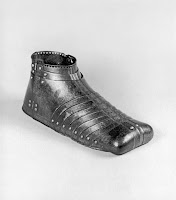 |
| Art by Afalstein |
The other thing to note about The Notion Club Papers is that one of the works discussed early on is Out of the Silent Planet, the first book in C. S. Lewis' Cosmic Trilogy. What makes this interesting from a crossover world-building perspective is that Out of the Silent Planet ends with a conversation between the protagonist Elwin Ransom (in many ways a fictionalized Tolkien) and the un-named narrator (implicitly Lewis himself) discussing how they were going to publish an account of the story marketed as fiction. So, we can assume that the world of the Notion Club's psychic voyages is the same as Dr. Ransom's physical ones, and both are the far future of Middle-Earth. The last Cosmic Trilogy book, That Hideous Strength, also talks about Atlantis as "Numinor", strengthening the connection.
Another connection to the Cosmic Trilogy that only recently came to my attention is the result of the academic work of Brenton Dickieson, who in a 2016 blog post described his discovery of a hitherto unknown draft preface to The Screwtape Letters which attributed the acquisition and translation of the letters as being from none other than Dr. Elwin Ransom. As the following chart shows, Screwtape was written after Out of the Silent Planet but before its two true sequels (there's also the whole issue of the controversial The Dark Tower, which I have yet to read):
Now, this definitely shows that Lewis made a couple of false starts in developing the sequel to Out of the Silent Planet, and the extent to which he still considered Screwtape to be connected is an open question. Personally, I can think of a couple of episodes in Screwtape that support the connective interpretation, such as the incident where Screwtape "inadvertently assumes the form of a large centipede", similar to the end of the fight between Ransom and the Un-Man in Perelandra. And frankly, the idea of Wormwood and Screwtape as bent Eldila toiling away under the fallen Oyarsa Melkor is, to me at least, a pleasingly coherent one.
One final thought for this post, and that's how Lewis' claim to fame, The Chronicles of Narnia, might be brought into the ILCU. Unfortunately there is not, to my immediate recollection, a direct textual link between the Chronicles and the other works of the various Inklings. The penultimate book in the series, The Magician's Nephew, offers a few thematic links, such as a mention of Atlantis (not Numenor, this time), and the image shared with Tolkien's work of the universe being sung into existence. There are references to Sherlock Holmes and the Bastable children, which were used by Win Scott Eckert in his Crossovers series to fit the Chronicles into his post-Farmer Wold Newton work (a context in which I've mentioned The Notion Club Papers before), but a direct Inklings-only connection will require additional research.


















